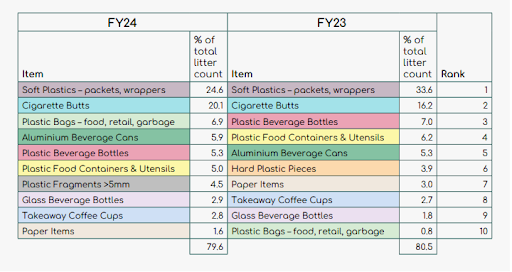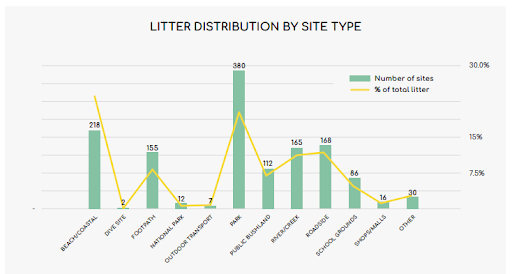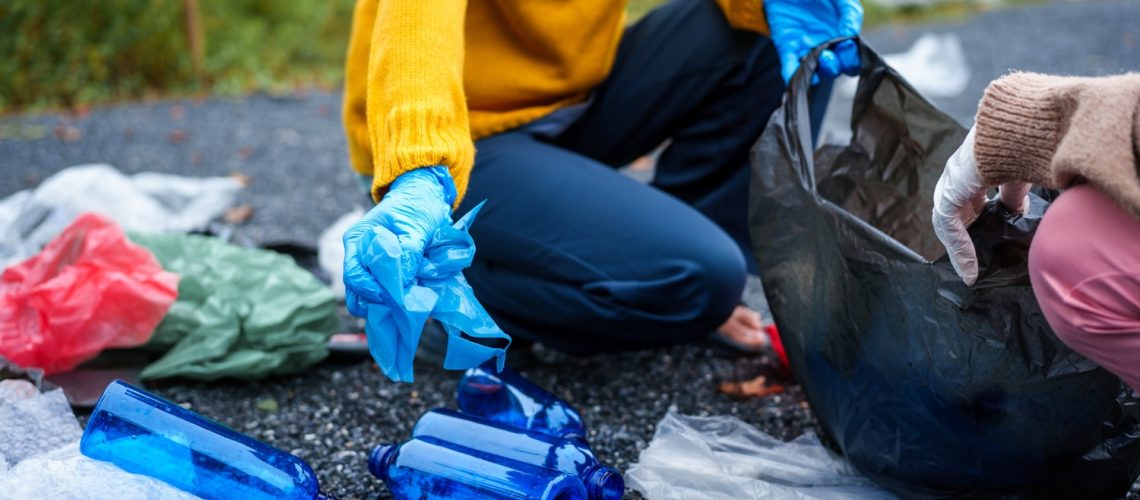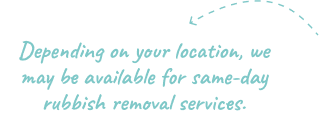Littering in Australia is a widespread but often overlooked problem with major environmental, economic, and public health consequences. Even though this information is widespread, only a few understand its dangerous impact.
Did you know that litter kills around 100,000 marine animals in Australia every year, including turtles and dugongs? Let us look at lesser-known facts and shocking statistics that provide insight into the scale, impact, and attitudes towards littering.
Aus Rubbish Removals provides an environmentally friendly waste service, helping to create cleaner communities across Australia. Our environmentally conscious approach to rubbish clearance ensures effective and efficient rubbish removal while minimising damage to the planet.
How Much Litter Do Australians Create?
Australia produced an estimated 75.6 million tonnes of waste in the 2022–23 period, based on the 2024 National Waste Recovery Report. This means approximately 2.88 tonnes are generated per person, showing the significant effect of individual consumption behaviour on overall waste production.
Compared to the last three surveys, the 2023/24 surveys recorded reduced counts and volumes of litter despite a small increase in the area surveyed. Although it’s a good finding, it is too early to assume any consistency in the number or volume of litter reduction.

Detailed accumulated litter data by site type for the 2023/24 year can be found in the table below, with further in-depth commentary by survey period further down this section.

Source: Government of Western Australia
Most Common Types of Litter in Australia
Soft plastics as a proportion of total reported litter decreased by 9% from FY23 to FY24, but this may be attributed to greater volunteer focused on collecting cigarette butts, cans, and other litter items.
In FY24, nurdles (small plastic pellets) and microplastics were an item from the survey, which made up 1.7% of all litter. Proportionately, soft plastics are still the most collected item.

Source: Clean Up Australia LITTER REPORT FY24 NATIONAL
Plastic bags have overtaken beverage bottles as the top 3 items consumed in FY23. Though plastic bottles can be returned to a CDS for recycling, plastic bags are a problem item without recovery options.
Meanwhile, food containers and utensils (takeaway) are consistently problematic litter items, demonstrating 5.0% of all litter reported between FY24.
Litter Hotspots: Where It Happens Most
38.2% of total reported litter across land and waterway sites was removed from waterway sites (beaches, dive sites, rivers and creeks only) in FY24 (GDP past data: 44.0% (FY23).
There were 22.2% of all reported litter nationally [16.7% in FY23] from parks. On the other hand, 8.2% of the total reported litter nationally was collected from bushland and national parks [11.7% for FY23].

Source: CleanUp Australia Litter Report FY24
Surprising Behavioural Insights Around Littering
Age groups most likely to litter: Studies suggest that littering is more common among younger people, particularly between 18 and 29. The reported littering prevalence for this age group was 26%, highlighting that littering is relatively common in this young adult group.
Littering while driving: According to the reports, around 18 people are reported daily for littering from cars in New South Wales.
Intentional vs accidental littering: Intentional littering is the deliberate disposal of waste products in unsuitable locations. The most littered items include cigarette butts, fast food wrappers, and drink containers.
On the other hand, accidental littering is done improperly without intent to discard rubbish, most often due to negligence or forgetting. It occurs when someone accidentally drops litter or empties their pocket or bag during a diversion.
Public awareness vs behaviour gaps: Its environmental impact includes extensive plastic pollution, devastating marine wildlife, with an annual input of about 130,000 tonnes of plastic into marine ecosystems that harm biodiversity on a huge scale.
Despite increasing awareness about littering, many still participate in this behaviour, with younger generations continuing to litter the most. Of those who observe littering, approximately 60% notify the proper channels, indicating that awareness does not always result in action.
Litter is usually left close to the bins. More than 50% of littering took place within 5m of a litter bin.
Plastic Litter: A National Environmental Threat
Based on the Australian Plastic Flows and Fates Study 2020-21 National Report, the country has consumed 3,791,000 tonnes of plastic. This number highlights the amount of plastic material produced across different sectors, from home to commercial to industrial. Alarmingly, just 15% of the plastic waste generated in Australia over the last 20 years has been recovered.
It was estimated that at least 85% of all the seabirds in Australia are impacted by plastic pollution, whether through ingestion or entanglement. This issue is worsened by a significant rise in plastic usage, which is expected to reach more than 1 million tonnes of short-life plastic over the same time frame up to 2023.
Furthermore, according to forecasts, if prevailing trends remain, plastic consumption could rise more than 200% by 2050.
Trends in Single-Use Plastic Bans
From 2021 onward, several Australian states have banned various single-use plastics. Notable actions include:
- New South Wales: The state passed a lightweight plastic shopping bag ban in June 2022, which was followed by a wider ban on single-use plastics (straws, stirrers, cutlery, and expanded polystyrene food containers) that began in November 2022.
- Victoria: On February 1, 2023, single-use plastic straws, cutlery, plates, drink stirrers, and food containers made from EPS were banned.
- South Australia: On March 1, 2021, South Australia banned the sale and distribution of many single-use plastic items, including cutlery and straws, and implemented new bans on some single-use plastic items. This also included plastic pizza savers and single-use plastic beverage containers, which came into effect on September 1, 2024.
- Queensland: This state banned single-use plastic straws, cutlery and plates from September 1, 2021, and more items and heavyweight plastic bag regulations will follow.
- Australian Capital Territory (ACT): In the ACT, scheduled restrictions form a random approach where specific single-use plastics were banned in July 2022, with another set to join them in January 2024, including prohibiting all plastic shopping bags.
Promoting Plastic Reduction
Alongside these bans, several significant initiatives have been introduced to aid the reduction of plastic consumption and support improved recycling:
Some states (NSW and QLD) have a container deposit scheme that allows you to receive incentives by returning beverage containers to be recycled, working towards a closer circular economy of waste management.
Public education campaigns, including initiatives like “Clean Up Australia Day”, encourage communities nationwide to participate in litter collection efforts and educate the public about plastic pollution and its environmental impact.
Federal, state and territory governments in Australia go beyond state-level initiatives. They developed a national framework to support sustainable packaging and reduce unnecessary single-use plastics as part of a wider set of environmental policies.
Cigarette Butts – Australia’s #1 Litter Item
Due to several interconnected aspects (including behaviours, socio-cultural context and environmental features), cigarette butts represent the most littered item in Australia.
Smoking culture remains quite strong in Australia, and recent statistics suggest that around 2.3 million people in Australia smoke cigarettes daily. The total number of cigarettes that people smoke is a direct contributor to the large number of discarded butts. About 18 billion cigarettes are smoked in Australia every year, and up to half are littered.
Cigarette butts are small and light and easy to throw away. Additionally, they’re very mobile and often blown by the wind or washed away in the rain, making their way into waterways and ecosystems.
Cigarette filters mainly contain cellulose acetate, which does not biodegrade and lasts for decades in the environment, adding to the litter problem. These materials release toxic substances as they decompose, extending their hazardous effects to wildlife and the environment.
The True Cost of Littering
The estimated costs associated with litter management, such as clean-up and disposal, for local councils across Australia are between $300 million and $350 million each year. In particular, councils could spend millions of dollars on cleaning products and labour to maintain public places impacted by litter.
The bulk of litter management responsibility lies with local councils, who spend considerable sums to keep the streets clean. In Sydney, estimates specify that 15,000 cigarette butts are cleaned from city streets each day, showing the scale of the problem.
Littering has grave implications for stormwater infrastructure, leading to overburdened drainage systems and increased flooding risk when waste is thrown away rather than placed in a trash bin. Uncontrolled litter on land is carried away when it rains into stormwater drains, contaminating the nearby water.
Moreover, it greatly affects tourism because litter can ruin scenic areas. It is estimated that an increase in litter can cause a 60% reduction in tourist stay.
Enforcement Efforts and Fines Across Different States
NSW: Programs and funding are enforced to improve waste management solutions and reduce littering altogether. The state imposes on-the-spot fines of $250 to a maximum fine of $2,200 in court.
Victoria: The enforcement mechanism in Victoria has developed a toolkit for litter authorities and officers, highlighting education, investments in infrastructure, and actual enforcement measures. Litter fines in Victoria can vary widely depending on the type of litter. A person could be fined $385 for small littering, such as cigarette butts or food packaging, and penalties can rise to $6,342 for more serious littering offenses.
Queensland: The state has established stand-alone litter and illegal dumping legislation with various penalties. The fines for general littering can range from $220 to $18,150, especially when taken to court.
Western Australia: Western Australian officers, police and litter act designates authority to issue on-the-spot fines. Littering can result in a maximum $5,000 fine for an individual and $10,000 for a corporation if the matter is taken to court.
South Australia: The Local Nuisance and Litter Control Act 2016 provides local councils with a wide range of powers to address littering and enforce compliance. On-the-spot fines go between $210 and $1,000, with larger amounts possible if a judge gets involved, where individuals can be penalised up to a maximum of $120,000.
Tasmania: The Tasmanian EPA addresses littering through environmental education, compliance monitoring, and enforcement actions under the Litter Act. Littering even minor items, such as a balloon, incurs a fine of roughly $404 as part of the Litter Act 2007, or two penalty units, according to the State Government website.
Australian Capital Territory: The ACT has a framework that can include rectification works or fines. The state imposes penalties between $60 and $200, while serious littering offences relating to illegal dumping can attract penalties of up to $5,000.
Northern Territory: The NT EPA engages in enforcement activity through statutory litter regulations and penalties. The littering fines start at $119 for individuals and jump to $656 for littering or illegal dumping for corporations.
What’s Being Done to Reduce Litter
Major Government and Non-Profit Campaigns
Keep Australia Beautiful: Operating as a national body with state-based offices and local community groups, KAB promotes sustainable living practices.
Their mission is to inspire and empower all Australians to take action to protect the environment for future generations. It supplies communities, businesses, schools, and Australians with options to do their bit through various programs and initiatives.
National Waste Policy Action Plan: It outlines the direction for Australia’s transition to a safe circular economy. The plan identifies where Australia needs to direct its efforts to reduce waste and increase recycling.
This overarching plan sets out seven national targets to be achieved by 2030, including reducing total waste generated by 10% per person and an average resource recovery rate of 80% from all waste streams.
The Pacific Ocean Litter Project (POLP): Australia’s largest international investment in the global fight against marine pollution, an AU$16 million investment from 2019-2027.
This project is designed to address marine plastic litter in the coastal environments of the Pacific island countries, focusing on trash, and reduce and replace initiatives for single-use plastics such as plastic bottles, bags and food containers.
How Aus Rubbish Removals Helps Keep Communities Clean
With over 10 years of experience in different rubbish removal jobs, Aus Rubbish Removals has been playing a great role in helping keep homes and businesses in Sydney clean. Our unparalleled service guarantees that waste removal is done efficiently and gradually, and eco-accommodating disposal techniques are imperative.
Furthermore, we set aside recyclables from waste and sort them to protect the environment, the same way we always consider your health first.
Let us handle your rubbish removal needs. Call us at 0402 244 036 for a FREE quote. We provide same-day rubbish removal service and are available 24/7. Our service areas include North Sydney, Manly, Mosman, Sydney CBD, Chatswood, Willoughby, and Hornsby.
Frequently Asked Questions
1. What is the most littered item in Australia?
Clean Up Australia notes that cigarette butts are the most littered item.
2. How much does littering cost the country?
Littering costs the Australian economy over $1.2 billion annually through cleanup costs and impacts on property values and tourism.
3. How long does litter stay in the environment?
Litter is composed of several different types of materials, each with its own decomposition time, depending on its composition. For instance, cigarette butts can decompose over 1 to 5 years, plastic bags take between 10 and 20 years to fully decompose while plastic-coated food wrappers likely take about 5 years.
4. What fines apply for littering in NSW or VIC?
For minor offences, littering can result in a fine of $250 in NSW, and serious cases can result in fines of up to $2,200 if prosecuted in court. In Victoria, littering fines can be as low as $385 for tiny articles and as high as $790 for lit cigarettes or hazardous litter.
5. What are the best ways to reduce litter in your area?
The community, infrastructure, and educational approaches can collaborate well. This results in massive litter reduction and a cleaner environment for many.



